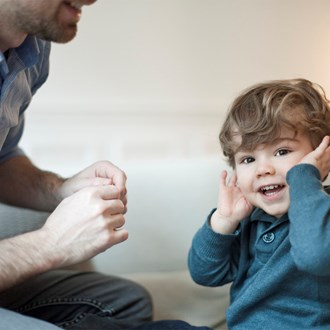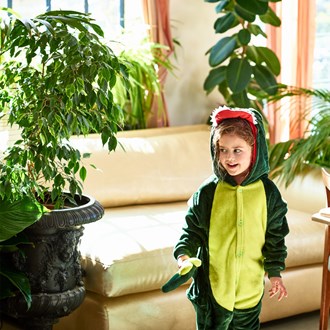How to deal with a clingy toddler (without losing your mind!)

Sometimes the most adventurous toddler can go through a clingy phase, here are some tips to help you cope
By Practical Parenting team
February 04 2019
Why is my toddler clingy and whiny?
So your toddler has been exercising her new found independence for some time. She has been taking her naps without problems and settling down at night with a good routine. However, almost all toddlers will reach the CLINGY stage in their development. This is usually around the ages of 15 months to two-years-old and sometimes even beyond. So be prepared, you may find yourself with a baby anaconda wrapped around your leg!
Whether it’s grabbing your legs, screaming when you disappear from sight or just wanting to be picked up and cuddled all the time, don't be surprised if you're constantly asking, 'why is my toddler so clingy and whiny?' but it is an absolutely normal part of their development.
Often clinginess comes in phases but triggers can include a new stage in their life like a new sibling, mum being pregnant, moving house or starting at daycare or pre-school.
Lack of trust in other grown-ups can also affect how clingy your toddler is, especially when you have to leave them for they first time in the care of someone else. This is often called separation anxiety.
How to deal with a clingy toddler
Although it's frustrating for you, try and show as much compassion and understanding as you can as your toddlers fears feel very real to them. Avoid using a harsh tone, but do hold firm and don’t give in to every demand. You're the one in control here, as hard as that can be to remember! Toddlers often start being clingy around the 15-month mark but it can be older and younger.
Here are some common triggers for clinginess!
1. Leaving your child with another carer

Getty
If you have to leave your child with a babysitter, at a daycare or with a friend, you might find your distressed toddler will hold your legs or want to be picked up in a bid to stop you leaving them. They might even go into epic tantrum mode. This can be upsetting for both of you.
- Most daycares suggest that you try leaving your toddler with them for a few hours over a few different days before their first full day and this is a great idea, so talk to them about their orientation program. It's a chance to get used to being with another carer and in a different environment, and your child can learn to understand that you will always return.
- Leave plenty of time during the drop-off so you're not rushing off to work or an appointment and your toddler doesn't feel abandoned.
- Give her a hug and confidently assure your toddler that you will collect her at the end of the day. This ensures that your little one knows you will be back. Whatever you do, and however hard it is, try not to get upset in front of her as she will pick up on your anxiety and stress and mirror it. It can also be very confusing.
- Make sure you leave your child in the company of another adult when you go, so they have someone to guide them into a fun activity.
- Don't just sneak away when your toddler is playing as this can cause distrust and anxiety if you suddenly just disappear. Try not to look back once you have said your good-byes.
- When you arrive to collect your toddler, you may find they burst into tears. Usually this is because they overwhelmed by emotion and can't express how they feel. It doesn't mean they've had a bad day. Don't panic!
2. Expecting a new baby

Getty
If you are expecting a new baby, try to involve your toddler as much as you can in the process so they feel secure in their role within the family.
For example, allow her to choose a colour for the new nursery, to touch your tummy when you’re hugging her and reassure your child that you will always love them and that they will be the big brother or sister to the new baby. This should reduce their fears of the new arrival.
3. Having a new baby in the house

Getty
Bringing home a new baby and introducing him to your toddler can be a confusing and stressful time for everyone, but there are ways to help ease the situation.
- After the birth, arrange for your child to meet the baby as soon as possible. It's a good idea for the toddler to present the baby with a gift like a blanket or new teddy bear. Even giving the new bub a drawing can help your pre-schooler feel like they are a key part of this experience.
- You may want to have your hands free when your child arrives so you can focus on greeting her before introducing her to the baby. If she arrives while you're feeding, ask her to come over and check out the baby's feet and hands, and try to maintain eye contact with your toddler as much as you can. Smile and reassure her that you're still the same mummy you were before you gave birth!
- Once you introduce her to her sibling, allow your child as much contact with the baby as possible. Show her the baby and let her (gently) get to know him by touching his feet and talking to him.
- Then, try and leave your newborn with your partner or another carer while you cuddle and talk to your toddler about their day and what they have been doing while you've been apart.
- Some mums find their toddlers 'regress' and act more like younger babies. They want to be held and want all of mummy's attention. This is totally normal so try not to get frustrated or angry - they might just be jealous or confused.
- Don't push your toddler or shame her to be a "big girl." Cuddle her and tell her how much you love her and how you're so proud of her while encouraging any signs of independence. If she shows any signs of independence, reinforce that tendency by giving him positive re-enforcement.
If your child is under two when you bring the baby home
If your child is aged between 15 months and 23 months old, it can be tough for a firstborn to accept a new baby. Psychologist Dr Fran Walfish, the author of The Self-Aware Parent says it's normal for your child to be clingy and throw tantrums if they don't get you all to their self. 'Don't fall into the trap of negotiating or pleading with your child," she says. 'If she whines that she wants you to pick her up but you're nursing the baby, tell her: "You're sad that I can't pick you up right now. I'm sad too. Come snuggle up next to me and the baby. And when I'm finished, let's hug!'
If your child is between two and three when you bring the baby home
Many children of around 24 months can become weepy, whiny, or clingy, especially after the novelty of a new baby wears off. Kids may want to breastfeed again when they see the attention their little sibling gets and bedtimes may drag out as your toddler acts up to get attention from you.
Unfortunately this new bedtime 'routine' often collides with the new baby's 'witching hour' so it can be overwhelming for you and them.
You might also find a child who has been sleeping in his own bed may suddenly want to sleep in yours, especially if the baby is in your room and he may start night-waking again. 'Most toddlers and preschoolers feel very conflicted about a new sibling. A part of them just wants to be a baby and another part wants independence," says psychologist Jenn Berman, author of The A to Z Guide to Raising Happy, Confident Kids.
Try to validate your child's emotions by verbally recognising what is going on. Try something like, 'I can see you want to be a baby again right now. Shall we play babies?' but when you've finished the game, firmly put an end to that time and try to encourage as much independence as you can.
To help your child adjust to her new daily life, plan ahead while you're pregnant. Try to condense bed time routines so your child doesn't feel suddenly abandoned.
If the baby will be sleeping in your older child's cot, buy a toddler bed months before the baby arrives (or get another cot) so there aren't too many changes all at once. It's a massive lifestyle change when you add another person to a family so just recognising that your toddler feels upset is enough.
3. If there's no apparent reason for the clinginess!

Do not panic. It doesn't mean that your child will always be like this. It just means that they are going through a developmental stage and they feel reassured to have you within reach. The older she gets, the more she understands that she is separate from you and this is a new feeling. She clings to you for reassurance that she has someone on her side in a big and scary world.
- If your toddler won't let you out of her sight, try and tell her what you are doing before you do it. So you might say that you are going to the toilet before you go and that you will be back in five minutes. When you come back into the room, announce that you are back and smile so your baby learns that if you leave, you will return exactly as you said you would.
- Distraction can be a wonderful tool! If your child grizzles or whines, show them a book or toy. Try and encourage them to play alone with it, so you don't always have to be included.
- Avoid ignoring, discouraging or punishing clingy behaviour but try to praise your child when she shows independance.
Clingy toddlers and bedtime

Toddlers become more clingy when they are ill, teething or just plain tired. At this time your strategy must be consistent.
- Talk quietly, reassure your child with sentences like 'It is time for sleep now' or 'It's time for bed now. Goodnight'. Be firm but kind.
- Develop a good bedtime routine. If you haven’t already, work to create a soothing bedtime routine for your baby or toddler. This will help her relax before bed. It will also provide the kind of consistency and predictability that she needs to feel safe.
- Keep things light. When you look worried or lose your temper you simply send a message to your toddler that bedtime is stressful. Instead, work to keep things light and calm at bedtime and nap time. If you seem relaxed and confident, it’ll help your baby or toddler feel that way, too.
- Comfort your child when she needs it, but DO NOT create new habits. If your baby or toddler is screaming at bedtime and is fussy or cranky, wakes in the middle of the night, definitely comfort her. This is reassuring and lets her know you’re nearby. However, keep these interactions short and boring. This is not the time to turn on lights, read books, sing songs, or play games. Remember, you don’t want to create bad bedtime habits during this phase, so now isn’t the time to start sleeping on your child’s floor, or sitting in a rocker next to her bed.
Related tags
clingy /













